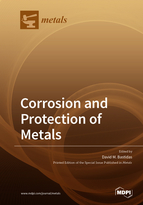Corrosion and Protection of Metals
A special issue of Metals (ISSN 2075-4701). This special issue belongs to the section "Corrosion and Protection".
Deadline for manuscript submissions: closed (31 December 2019) | Viewed by 67166
Special Issue Editor
Interests: corrosion engineering; materials science; electrochemistry; chemistry of materials; metallurgy
Special Issues, Collections and Topics in MDPI journals
Special Issue Information
Dear Colleagues,
During the last decades, an enormous effort has been made to understand Corrosion Phenomena and their mechanisms, and to elucidate the causes that dramatically influence the lifetime in service of metal materials. Metal materials performance in aggressive environments is critical for a sustainable society. Materials failure in service impacts the economy, the environment, health, and society. In this regard, corrosion economic losses due to maintenance, repair, and replacement of existing structures and infrastructure account for up to 4% of GDP (gross domestic product) in well developed countries.
One of the biggest issues in corrosion engineering is to estimate the service lifetime. This becomes very difficult, as there is no direct correlation with service lifetime and experimental lab results, usually as result of accelerated testing and real corrosion processes. This issue is of particular concern for society, since existing structures and infrastructure are getting old, and now crucial decisions must be made to replace them.
On the other hand, environmental protocols seek to reduce greenhouse effects. Therefore, low emission policies, in force, establish regulations for the next generation of materials and technologies. Advanced technologies and emergent materials will enable us to get through the next century. Great advances are currently in progress to develop corrosion resistances metal materials for different sectors such as energy, transport, construction, and health.
This Special Issue on Corrosion and Protection of Metals is focused on current trends in corrosion science, engineering, and technology, thus covering subjects related to corrosion mechanism & modelling, protection and inhibition processes, and mitigation strategies. Topics on all aspects of corrosion are invited to contribute to this Special Issue.
Prof. Dr. David M. Bastidas
Guest Editor
Manuscript Submission Information
Manuscripts should be submitted online at www.mdpi.com by registering and logging in to this website. Once you are registered, click here to go to the submission form. Manuscripts can be submitted until the deadline. All submissions that pass pre-check are peer-reviewed. Accepted papers will be published continuously in the journal (as soon as accepted) and will be listed together on the special issue website. Research articles, review articles as well as short communications are invited. For planned papers, a title and short abstract (about 100 words) can be sent to the Editorial Office for announcement on this website.
Submitted manuscripts should not have been published previously, nor be under consideration for publication elsewhere (except conference proceedings papers). All manuscripts are thoroughly refereed through a single-blind peer-review process. A guide for authors and other relevant information for submission of manuscripts is available on the Instructions for Authors page. Metals is an international peer-reviewed open access monthly journal published by MDPI.
Please visit the Instructions for Authors page before submitting a manuscript. The Article Processing Charge (APC) for publication in this open access journal is 2600 CHF (Swiss Francs). Submitted papers should be well formatted and use good English. Authors may use MDPI's English editing service prior to publication or during author revisions.
Keywords
- Corrosion & protection
- Inhibition
- Localized corrosion
- Environmentally assisted corrosion cracking
- Crevice corrosion
- Galvanic corrosion
- High temperature corrosion
- Atmospheric corrosion
- Corrosion of steel in concrete
- Modelling & simulation






